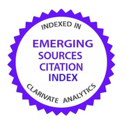Construcción de portafolios considerando momentos superiores para fondos de inversión
DOI:
https://doi.org/10.26360/2024_01Palabras clave:
retorno, asimetría, curtosis, optimización de carteraResumen
El objetivo de este estudio es construir un portafolio utilizando Momentos Superiores y considerando activos tipo ETF. Se emplea una metodología cuantitativa que no solo se basa en la normalidad de la utilidad esperada, sino también en la inclusión de momentos superiores. El objetivo final es optimizar la utilidad de cada portafolio y determinar los tres mejores. Al analizar los rendimientos de la cartera compuesta por los activos LABU, PSQ, FXI, SPY e IWM, se observó una disminución en los rendimientos tanto en términos absolutos como porcentuales al considerar momentos superiores. Bajo condiciones de normalidad, la mayoría de los activos registraron rendimientos negativos, y esta tendencia se intensificó al incluir momentos superiores. En relación a los portafolios, se encontró que el Portafolio 2 mostró un desempeño destacado en términos de utilidad bajo la suposición de normalidad. A pesar de tener una curtosis notablemente más alta que los demás portafolios, este portafolio exhibió una media positiva más alta y una volatilidad más baja. Sin embargo, al considerar la ecuación de momentos superiores, se reveló que ninguno de los portafolios era viable como opción de inversión, lo que indica un mayor riesgo en todos ellos.
Descargas
Citas
Arditti, D. (1967). Risk and the required return on equity. The Journal of Finance, 22(1), 19-36. https://doi.org/10.2307/2977297
Aksaraylı, M., y Pala, O. (2018). A polynomial goal programming model for portfolio optimization based on entropy and higher moments. Expert Systems with Applications, 94, 185-192. https://doi.org/10.1016/j.eswa.2017.10.056
BlackRock (2023). iShares Russell 2000 ETF. https://www.blackrock.com/cl/productos/239710/ishares-russell-2000-etf
Bergh, G., y Rensburg, P. (2008). Hedge funds and higher moment portfolio selection. Journal of Derivatives & Hedge Funds. https://doi.org/10.1057/JDHF.2008.14
Brito, R. P., Sebastião, H., y Godinho, P. (2019). Portfolio management with higher moments: the cardinality impact. International Transactions in Operational Research, 26(6), 2531-2560. https://doi.org/10.1111/itor.12404
Charupat, N., y Miu, P. (2013). The pricing efficiency of leveraged exchange‐traded funds: evidence from the US markets. Journal of Financial Research, 36(2), 253-278. https://doi.org/10.1111/j.1475-6803.2013.12010.x
Dahlquist, M., Farago, A., y Tédongap, R. (2017). Asymmetries and portfolio choice. The Review of Financial Studies, 30(2), 667-702. https://doi.org/10.1093/rfs/hhw091
Fama, E. F. (1965). The behavior of stock-market prices. The journal of Business, 38(1), 34-105.
Harvey, C.R., Liechty, J.C., Liechty, M.W., y Mueller, P. (2010). Portfolio selection with higher moments. Quantitative Finance, 10, 469 - 485. http://dx.doi.org/10.1080/14697681003756877
Harvey, C. R., y Siddique, A. (1999). Autoregressive conditional skewness. Journal of financial and quantitative analysis, 34(4), 465-487. https://doi.org/10.2307/2676230
Gong, X., Yu, C., Min, L., & Ge, Z. (2021). Regret theory-based fuzzy multi-objective portfolio selection model involving DEA cross efficiency and higher moments. Applied Soft Computing, 100, 106958. https://doi.org/10.1016/j.asoc.2020.106958
Jean, W. H. (1971). The extension of portfolio analysis to three or more parameters. Journal of financial and Quantitative Analysis, 6(1), 505-515. https://doi.org/10.2307/2330125
Konno, H., Hiroshi, S., y Hiroaki, Y. (1993). A mean-absolute deviation-skewness portfolio optimization model. Annals of Operations Research. 45(1), 205-220.
Lai, T. Y. (1991). Portfolio selection with skewness: a multiple-objective approach. Review of Quantitative Finance and Accounting, 1, 293-305. https://doi.org/10.1007/BF02408382
Levy, H., y Arditti, F. D. (1975). Valuation, Leverage and the Cost of Capital in the Case of Depreciable Assets: A Reply. The Journal of Finance, 30(1), 221-223. https://doi.org/10.2307/2978446
Levy, H., y Markowitz, H. M. (1979). Approximating expected utility by a function of mean and variance. The American Economic Review, 69(3), 308-317. https://www.jstor.org/stable/1807366
Markowitz, H. (1952). The utility of wealth. Journal of political Economy, 60(2), 151-158.
Mandelbrot, B. (1963). New methods in statistical economics. Journal of political economy, 71(5), 421-440. https://doi.org/10.1086/258792
Molina, M. (2022). Paso a paso. Prueba de la t de Student para muestras independientes. Revista electrónica AnestesiaR, 14(8), 1 - 5. https://doi.org/10.30445/rear.v14i8.1060
Pierro, M. D., y Mosevich, J. (2011). Effects of skewness and kurtosis on portfolio rankings. Quantitative Finance, 11(10), 1449-1453. https://doi.org/10.1080/14697688.2010.495723
Peiro, A. (1999). Skewness in financial returns. Journal of Banking & Finance, 23(6), 847-862. https://doi.org/10.1016/S0378-4266(98)00119-8
Premaratne, G., y Bera, A. K. (2000). Modeling asymmetry and excess kurtosis in stock return data. Illinois Research & Reference Working Paper No. 00-123. http://dx.doi.org/10.2139/ssrn.259009
Vilella, F. (2020). Rebrotes del Covid-19 mantendrán en auge a sectores ya beneficiados. Revista Uruguaya de Economía y Finanzas Personales, Portfolio, 102(8), 29 – 32.
Saranya, K., y Prasanna, P. K. (2014). Portfolio selection and optimization with higher moments: Evidence from the Indian stock market. Asia-Pacific Financial Markets, 21, 133-149. https://doi.org/10.1007/s10690-014-9180-0
Salinas, S. M., Maldonado, D. A., y Díaz, L. G. (2010). Estimación del riesgo en un portafolio de activos. Apuntes del CENES, 29(50), 117-150.
Sweta, K. (2023). Top-Ranked ETFs to Buy on Small-Cap Comeback. Yahoo Finance.
Steyn, J. P., y Theart, L. (2021). The pricing of skewness: Evidence from the Johannesburg Stock Exchange. Investment Analysts Journal, 50(2), 133-144. https://doi.org/10.1080/10293523.2021.1898744
TYVA (2023). Qué es el ETF SPY. https://tyba.com.co/blog/spy/
Xu, Z., Li, X., y Chevapatrakul, T. (2019). Return Asymmetry and the Cross Sección of Stock Returns. Social Science Research Network. http://dx.doi.org/10.2139/ssrn.2850842
Zhu, F., Luo, X., y Jin, X. (2019). Predicting the volatility of the iShares China Large-Cap ETF: What is the role of the SSE 50 ETF?. Pacific-Basin Finance Journal, 57, 101192. https://doi.org/10.1016/j.pacfin.2019.101192
Publicado
Versiones
- 12-12-2024 (2)
- 31-07-2024 (1)
Cómo citar
Número
Sección
Licencia
Derechos de autor 2024 Genjis Ossa Gonzalez, Miriam Rojas Domínguez

Esta obra está bajo una licencia internacional Creative Commons Atribución-NoComercial-SinDerivadas 4.0.


















